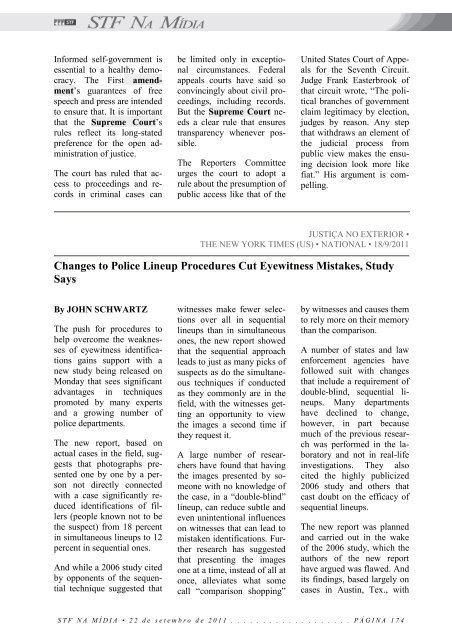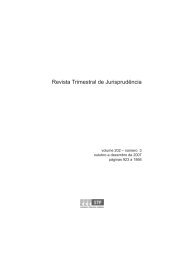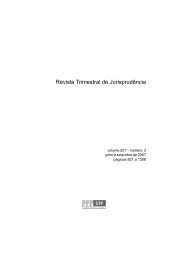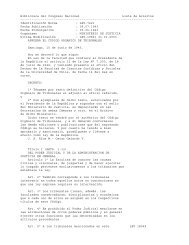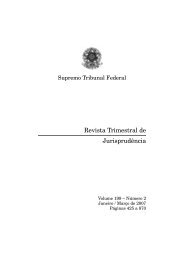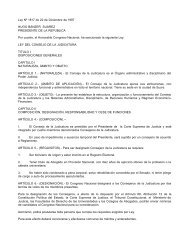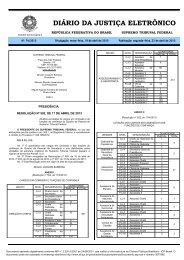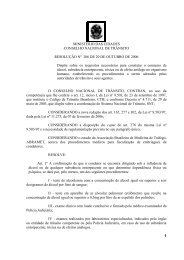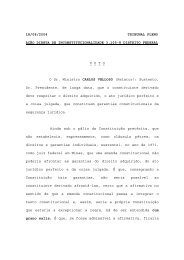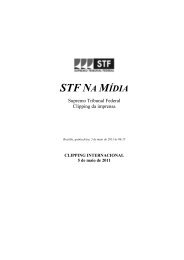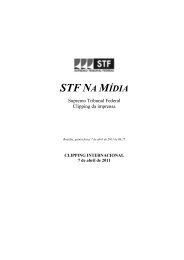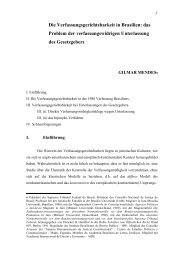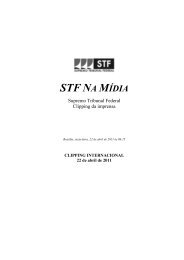STF NA MÍDIA
STF NA MÍDIA
STF NA MÍDIA
Create successful ePaper yourself
Turn your PDF publications into a flip-book with our unique Google optimized e-Paper software.
Informed self-government is<br />
essential to a healthy democracy.<br />
The First amendment’s<br />
guarantees of free<br />
speech and press are intended<br />
to ensure that. It is important<br />
that the Supreme Court’s<br />
rules reflect its long-stated<br />
preference for the open administration<br />
of justice.<br />
The court has ruled that access<br />
to proceedings and records<br />
in criminal cases can<br />
be limited only in exceptional<br />
circumstances. Federal<br />
appeals courts have said so<br />
convincingly about civil proceedings,<br />
including records.<br />
But the Supreme Court needs<br />
a clear rule that ensures<br />
transparency whenever possible.<br />
The Reporters Committee<br />
urges the court to adopt a<br />
rule about the presumption of<br />
public access like that of the<br />
United States Court of Appeals<br />
for the Seventh Circuit.<br />
Judge Frank Easterbrook of<br />
that circuit wrote, “The political<br />
branches of government<br />
claim legitimacy by election,<br />
judges by reason. Any step<br />
that withdraws an element of<br />
the judicial process from<br />
public view makes the ensuing<br />
decision look more like<br />
fiat.” His argument is compelling.<br />
JUSTIÇA NO EXTERIOR •<br />
THE NEW YORK TIMES (US) • <strong>NA</strong>TIO<strong>NA</strong>L • 18/9/2011<br />
Changes to Police Lineup Procedures Cut Eyewitness Mistakes, Study<br />
Says<br />
By JOHN SCHWARTZ<br />
The push for procedures to<br />
help overcome the weaknesses<br />
of eyewitness identifications<br />
gains support with a<br />
new study being released on<br />
Monday that sees significant<br />
advantages in techniques<br />
promoted by many experts<br />
and a growing number of<br />
police departments.<br />
The new report, based on<br />
actual cases in the field, suggests<br />
that photographs presented<br />
one by one by a person<br />
not directly connected<br />
with a case significantly reduced<br />
identifications of fillers<br />
(people known not to be<br />
the suspect) from 18 percent<br />
in simultaneous lineups to 12<br />
percent in sequential ones.<br />
And while a 2006 study cited<br />
by opponents of the sequential<br />
technique suggested that<br />
witnesses make fewer selections<br />
over all in sequential<br />
lineups than in simultaneous<br />
ones, the new report showed<br />
that the sequential approach<br />
leads to just as many picks of<br />
suspects as do the simultaneous<br />
techniques if conducted<br />
as they commonly are in the<br />
field, with the witnesses getting<br />
an opportunity to view<br />
the images a second time if<br />
they request it.<br />
A large number of researchers<br />
have found that having<br />
the images presented by someone<br />
with no knowledge of<br />
the case, in a “double-blind”<br />
lineup, can reduce subtle and<br />
even unintentional influences<br />
on witnesses that can lead to<br />
mistaken identifications. Further<br />
research has suggested<br />
that presenting the images<br />
one at a time, instead of all at<br />
once, alleviates what some<br />
call “comparison shopping”<br />
by witnesses and causes them<br />
to rely more on their memory<br />
than the comparison.<br />
A number of states and law<br />
enforcement agencies have<br />
followed suit with changes<br />
that include a requirement of<br />
double-blind, sequential lineups.<br />
Many departments<br />
have declined to change,<br />
however, in part because<br />
much of the previous research<br />
was performed in the laboratory<br />
and not in real-life<br />
investigations. They also<br />
cited the highly publicized<br />
2006 study and others that<br />
cast doubt on the efficacy of<br />
sequential lineups.<br />
The new report was planned<br />
and carried out in the wake<br />
of the 2006 study, which the<br />
authors of the new report<br />
have argued was flawed. And<br />
its findings, based largely on<br />
cases in Austin, Tex., with<br />
S T F N A M Í D I A • 2 2 d e s e t e m b r o d e 2 0 1 1 . . . . . . . . . . . . . . . . . . . P Á G I N A 1 7 4


